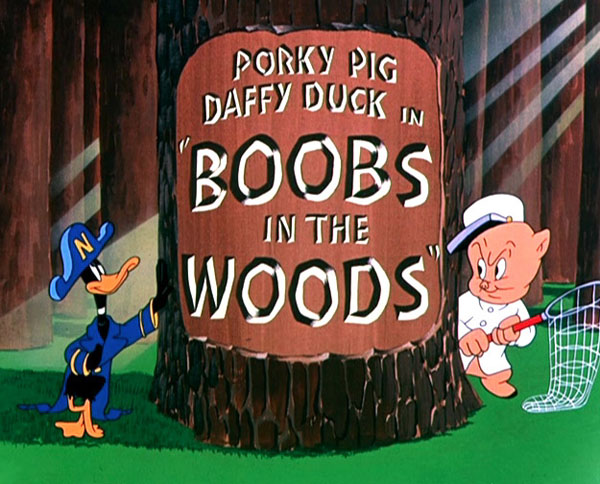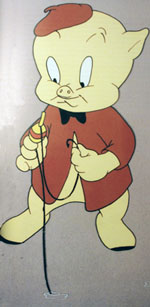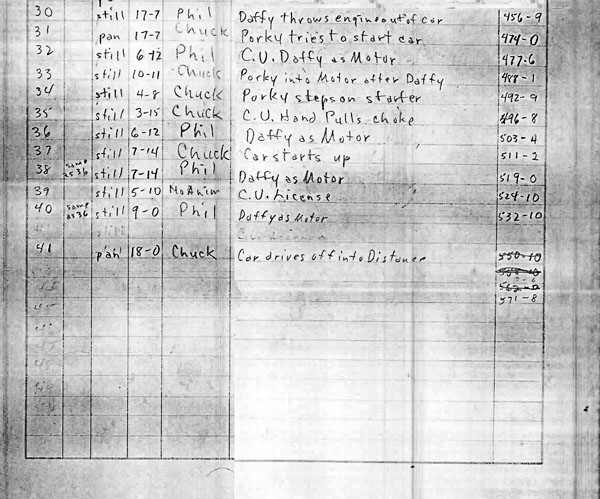
Oh, people call me Daffy
They think that I am goony
Just because I’m happy
Is no sign I’m looney-tooney!
Boobs in the Woods marks a lingering vestige of Daffy as a lunatic, as he originated from his screen debut; Bob McKimson directed only two more Daffy/Porky entries (1951’s The Prize Pest and 1952’s Thumb Fun) using this persona, until Daffy was depicted as conniving and greedy from thereon in. Compared to other titles starring Daffy released the same year, such as Chuck Jones’ expansive The Scarlet Pumpernickel, this cartoon appears as a remembrance; in one sequence in the film, Daffy exits by riding an imaginary tricycle, with a bell attached, lifted from an earlier film–Bob Clampett’s Porky and Daffy (1938).
 In this film, Porky Pig is essentially trapped with Daffy in the woods, but without any preference to hunt him, though he attempts to murder him — by shotgun and axe – on two different occasions. In some instances, Daffy heckles Porky by acting as a sort of woodland regulator—disputing infringement on having his own lake painted, posing as a sheriff (and executor) governing gun laws, and questioning if Porky possesses specific licenses, including one to sell hair tonic to bald eagles in Omaha, Nebraska.
In this film, Porky Pig is essentially trapped with Daffy in the woods, but without any preference to hunt him, though he attempts to murder him — by shotgun and axe – on two different occasions. In some instances, Daffy heckles Porky by acting as a sort of woodland regulator—disputing infringement on having his own lake painted, posing as a sheriff (and executor) governing gun laws, and questioning if Porky possesses specific licenses, including one to sell hair tonic to bald eagles in Omaha, Nebraska.
Emery Hawkins animates the amusing opening sequence as Daffy displays various nonsensical gags, set against an equally absurd song, which almost sounds like an off-key version of “The Merry-Go-Round Broke Down.” Hawkins also animates Daffy erasing his lake from Porky’s painting, followed by his disguise as “the old man of the mountains,” erasing the summits on the painting he claims are his. Starting as an inker at Lantz in 1930, at age 18, Hawkins was certainly a transitory animator, working in about every theatrical animation studio in the West Coast during the ‘30s and ‘40s, including Charles Mintz, MGM, Screen Gems, Disney– in three consecutive stints– arriving back to Walter Lantz in the early ‘40s—he served as a co-director there, as well– and moved over to Warners a few years later.
He moved away from theatricals into industrial films and television commercials, animating for John Sutherland, John Hubley’s Storyboard Inc., Playhouse Pictures, Pelican Films and Zander’s Animation Parlour. Hawkins associated with Bill Melendez—who animated on the “Daffy as Pocahantas” sequence and the zany baseball game in this film—later in his career, animating on the Peanuts television specials.
 Pete Burness handles a large section where Porky rushes back to his fishing lure, a bell, which Daffy rings to his attention–only to find nothing in the water. After he is duped a second time, Porky implicitly informs the audience he is wise to Daffy’s tricks, with a devious expression as he steps away. In the third attempt, Daffy rings again, but Porky catches him behind a rock; Burness’ trademark “pose-to-pose” attributes to his work are applied here, as the frightened Daffy is carried away by Porky to the chopping block.
Pete Burness handles a large section where Porky rushes back to his fishing lure, a bell, which Daffy rings to his attention–only to find nothing in the water. After he is duped a second time, Porky implicitly informs the audience he is wise to Daffy’s tricks, with a devious expression as he steps away. In the third attempt, Daffy rings again, but Porky catches him behind a rock; Burness’ trademark “pose-to-pose” attributes to his work are applied here, as the frightened Daffy is carried away by Porky to the chopping block.
Select contemporary songs in Carl Stalling’s musical score, composed for films released during Boobs in the Woods’ production, compliment the quaint woodland setting; Jules Styne and Sammy Cahn’s “There’s Music in the Land,” from the 1948 Warner Bros. film Two Guys from Texas, accompany the opening titles. Porky’s introduction and painting the landscape is a rare moment of tranquility, in a film that offers frivolous antics—the song used during these scenes is another Styne/Cahn tune entitled “Put ‘Em in a Box, Tie ‘Em with a Ribbon (and Throw ‘Em in the Deep Blue Sea),” originating from Romance on the High Seas (1948) with Doris Day. A composition from Raymond Scott seldom heard in Warners cartoons, “Singing Down the Road,” from the 1945 film Bells of Rosarita, is heard during the sequence with Porky’s fishing lure. (The music was by Scott, and Charles Tobias wrote the lyrics.)
The closing line of Daffy’s silly song, before submerging into the lake: “Good evening, friends…” is borrowed from Al Jolson, as he sung those words as a host in the beginning and end of the Shell Chateau (1935-37) radio program. The phrase may have earlier origins; however, it’s debatable if Jolson said it during his theater shows, before he appeared on radio. Daffy’s remark of disdain, after he reads Porky’s license to use him as a motor at the end of the cartoon—“What a revoltin’ development this is!”—was lifted from the character Chester A. Riley from the radio sitcom The Life of Riley.
Enjoy the breakdown video, ya crazies!


(Thanks to Michael Barrier and Keith Scott for their help.)


 DEVON BAXTER is a film restoration artist, video editor, and animation researcher/writer currently residing in Pennsylvania. He also hosts a
DEVON BAXTER is a film restoration artist, video editor, and animation researcher/writer currently residing in Pennsylvania. He also hosts a 



















































































Among Emery Hawkins many achievements is the awe inspiring Greedy from Richard Williams’ Raggedy Ann And Andy. It’s quite an amazing sequence with everything in the scenes constantly moving.
Bill Melendez steals the show in this short.
Please note this was originally released in 1950 as “Looney Tunes” cartoon. By the time this was reissued they simply didn’t care about series designations – as this reissue print sports a Merrie Melodies Blue Ribbon open, while retaining the original “Merry-Go-Round Broke Down” opening and closing soundtrack, and keeps the original “Looney Tunes” end title.
IMO, this is one of Robert McKimson’s best Porky/Daffy shorts – a silly but funny story by Warren Foster, along with great Emery Hawkins & Bill Melendez animation, makes this cartoon a truly LOONEY TUNE!!
I have a soft spot for Daffy’s Inn Trouble and Fool Coverage
Anyone know where the gag of using a Napoleon outfit to represent a crazy person started?
Well, that probably started when the psychiatric diagnosis “delusions of grandeur” entered the public consciousness. Soon, “guy thinks he’s Napoleon” became the comic shorthand.
There was indeed a cartoon in which “the real Napoleon” gets strafed by Bugs, and eventually carted off. Title?
‘Napoleon Bunny-part”, from 1956
I believe you’re referring to Friz Freleng’s Napoleon Bunny-Part from 1956.
http://www.straightdope.com/columns/read/2764/napoleon-complex
Famous Studios-worthy torture ending gag.
First of all, thank you, Jerry Beck, for clearing up the mix-up of the opening and closing. I agree that they just don’t care too much anymore for accuracy, but I also think that, over time, partially because of the Warner Brothers cartoons filmography being split up between Warner Brothers and MGM/U.A., the libraries have gotten confused, and I think that, as the 24-carrot collection on VHS and, then, laserdisc, and finally DVD, were being restored, the cartoons are still “crawling” out of all that confusion. There were still mistakes made on the GOLDEN COLLECTION series as far as proper opening fanfares are concerned, but this entry, ‘BOOBS IN THE WOODS” is one, like “DAFFY DUCK SLEPT HERE” before it, of those quotable quotes types of cartoons, and Warner has a lively handful of those. From my dimming visual memory of this film, the scene as Daffy says to Porky “Well, why don’t you and me go steady?” is among the funniest, with Daffy literally wrapping himself around Porky as he recites the line! That’s the kind of lunacy we’d all come to expect from Daffy Duck, but I guess that the duck had to make some kind of change since, in some cases, Woody Woodpecker was trying to steal his thunder as the wackiest bird in the woods. Daffy still wins out for his zany wit, but it seems as if the tides had to turn, and Daffy had to change beyond just being a wacky little black duck. Hey, some of his turns in parodies of detective and police dramas, were also quite interesting, too.
Great points, Devon, about these McKimson cartoons containing the last gasp of the original Daffy Duck personality. I love THE PRIZE PEST, where Daffy dresses up as a monster to spook Porky. Very funny cartoon. It isn’t so bad that Chuck Jones experimented with Daffy’s persona and made him a little more vain and greedy, that was OK. For Chuck. However, for Chuck’s “experiment” to be set in stone forever, really dimmed Daffy’s appeal for me. The Daffy/Speedy cartoons were the outer extremities of the vain and greedy Duck, and you know what they were worth! Oh, Agony, A-Gon-EEEE! It’s also interesting how Bill Melendez uses almost as much dry brush in Boobs in the Woods as Don Williams did in his Art Davis cartoons, but the drawing is more regular.
Perhaps I’m reading too much into the Daffy personality change but it seems that Bob Clampett did some of the wildest early Daffys while Jones was still going through his “Disney-with water” phase. Since Jones’ dislike for Clampett and his approach to cartoons is no secret, perhaps Chuck took out his grudges by making Daffy a fall guy. Just sayin’.
Actually, Art, I’ve wondered the same thing myself regarding Jones and his interpretation of Daffy. The same with his interpretation of Bugs (ie. Bugs never goes after a foe unless the same foe strikes the first blow against him). I’ve often wondered if Jones’ approach to these characters was to make his “versions” of the characters was different from Clampett’s versions as possible. But, who knows? FWIW, Jones’ Bugs often ventured into more mischievous territory in certain cartoons of his such as “Hare Tonic”, “A Feather in His Hare”, “Rabbit Hood”, and, later on, “Rabbit’s Feat”. The same with his Daffy, early on (“Conrad the Sailor”, “My Favorite Duck”, “Daffy Duck and the Dinosaur”, “A Pest in the House”). Just shows how fully-rounded Chuck’s cartoons are.
Animation is great throughout this cartoon. What a team! The Burness animation is considerably different in style compared to his work for Jones on “Haredevil Hare”.
Directors had to know how to do film footage math. Not the easiest calculation.
I note that there are no unusual revelations in this draft. We have in the past seen so many scenes attributed to artists that were never credited officially.
I don’t think that the change in Daffy’s personality was as clear cut as a lot of other people do. He didn’t go from his Tex Avery persona to his DePatie-Freleng persona overnight.
The musical piece “Singing Down The Road” also appears in “Little Orphan Airedale” when Charlie Dog imitates all the people he sees, appropriately enough, walking down the street past him. A speeded up version accompanies Sniffles’ excited babbling in “Hush My Mouse”.